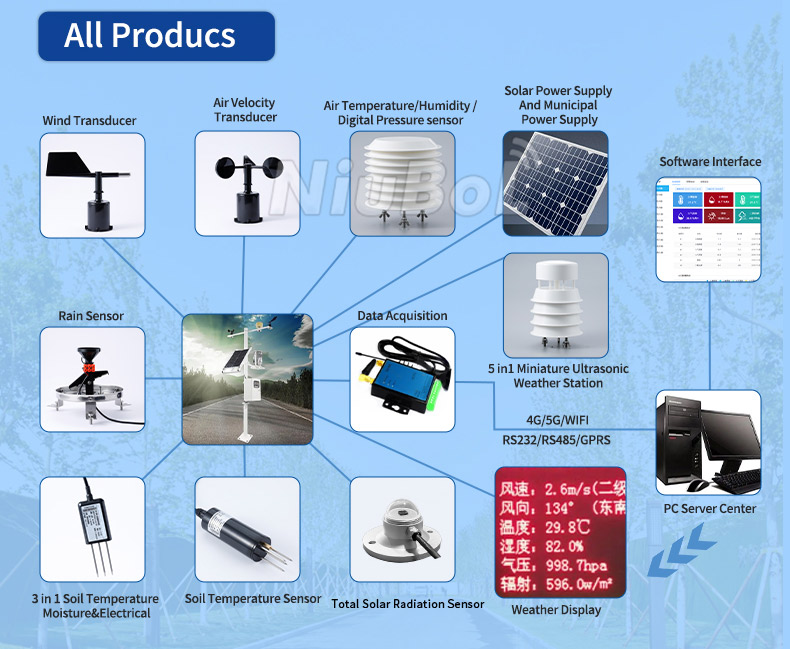

— Blogs —
—Products—
 Consumer hotline +8618073152920
Consumer hotline +8618073152920 WhatsApp:+8615367865107
Address:Room 102, District D, Houhu Industrial Park, Yuelu District, Changsha City, Hunan Province, China
Product knowledge
Time:2023-08-12 11:00:25 Popularity:786
The Photosynthetically Active Radiation (PAR) sensor is an instrument for measuring light energy utilisation by plants. It measures the intensity of photosynthetically active radiation, which is the plant's ability to absorb and utilise light in the spectral range. Below is an introduction, usage scenarios and uses of the Photosynthetically Active Radiation sensor:
Introduction to Photosynthetically Active Radiation Sensor:
The photosynthetically active radiation sensor is based on a light-sensitive device such as a photodiode or a photoresistor, which is capable of detecting and converting the intensity of light into an electrical signal. It is usually equipped in weather stations, farmland monitoring equipment or scientific research instruments to measure the intensity of photosynthetically active radiation.
Photosynthetically active radiation sensor use scene:
Agricultural field: photosynthetically active radiation sensor can be applied to farmland monitoring and crop growth management. By measuring the intensity of photosynthetically active radiation in real time, the light energy received by plants can be understood, so as to grasp the efficiency of photosynthesis and the use of light energy by plants. This is important for optimising the growing environment of crops and adjusting irrigation and fertilisation strategies.

Ecological studies: In ecosystem studies, photosynthetically active radiation sensors can be used to monitor the efficiency of light energy utilisation and carbon cycling in plant communities. By measuring the photosynthetically active radiation of different plants or vegetation types, it is possible to understand the biomass production, nutrient cycling and ecosystem functioning of plant communities. This contributes to a deeper understanding of ecosystem structure and function, and assesses ecosystem responses to climate change and human disturbance.
Greenhouse and indoor growing: In greenhouse and indoor growing, photosynthetically active radiation sensors can help regulate photosynthesis and artificial light sources. Depending on the intensity and wavelength range of photosynthetically active radiation, light settings can be optimised to provide appropriate light conditions to promote plant growth and development.
Meteorological observation: Photosynthetically active radiation is one of the important parameters in meteorological observation. Photosynthetically active radiation sensors can be equipped in weather stations to record changes in photosynthetically active radiation and provide climate and meteorological data. This helps in understanding the intensity of sunlight, seasonal variations in light energy use, and improvements in climate models and predictions.
Photosynthetically active radiation sensor uses:
Photosynthesis research: by measuring photosynthetically active radiation, important physiological processes such as plant response to photosynthesis, photosynthetic rate and productivity can be assessed.
Vegetation growth monitoring: Photosynthetically active radiation sensors can be used to monitor the growth and health of vegetation, and to detect changes in light energy use and adaptation.
Farmland management: By measuring photosynthetically active radiation, irrigation, fertilisation and nutrient management of farmland can be optimised to improve crop yield and quality.
Ecosystem assessment: Photosynthetically active radiation sensors can help assess the productivity, carbon cycle and ecosystem functions of different ecosystems, providing data support for ecological research.
In conclusion, photosynthetically active radiation sensors have a wide range of applications in agriculture, ecology, greenhouse cultivation and meteorological observation. By measuring the intensity of photosynthetically active radiation, it is possible to understand the light energy utilisation of plants, optimise management strategies, improve productivity and promote sustainable development.
Prev:Meteorological station equipment to monitor meteorological changes in areas of natural beauty
Next:Pyranometer: Key Instrument for Measuring Solar Radiation
Related recommendations
Sensors & Weather Stations Catalog
Agriculture Sensors and Weather Stations Catalog-NiuBoL.pdf
Weather Stations Catalog-NiuBoL.pdf
Related products
 Combined air temperature and relative humidity sensor
Combined air temperature and relative humidity sensor Soil Moisture Temperature sensor for irrigation
Soil Moisture Temperature sensor for irrigation Soil pH sensor RS485 soil Testing instrument soil ph meter for agriculture
Soil pH sensor RS485 soil Testing instrument soil ph meter for agriculture Wind Speed sensor Output Modbus/RS485/Analog/0-5V/4-20mA
Wind Speed sensor Output Modbus/RS485/Analog/0-5V/4-20mA Tipping bucket rain gauge for weather monitoring auto rainfall sensor RS485/Outdoor/stainless steel
Tipping bucket rain gauge for weather monitoring auto rainfall sensor RS485/Outdoor/stainless steel Pyranometer Solar Radiation Sensor 4-20mA/RS485
Pyranometer Solar Radiation Sensor 4-20mA/RS485
Screenshot, WhatsApp to identify the QR code
WhatsApp number:+8615367865107
(Click on WhatsApp to copy and add friends)